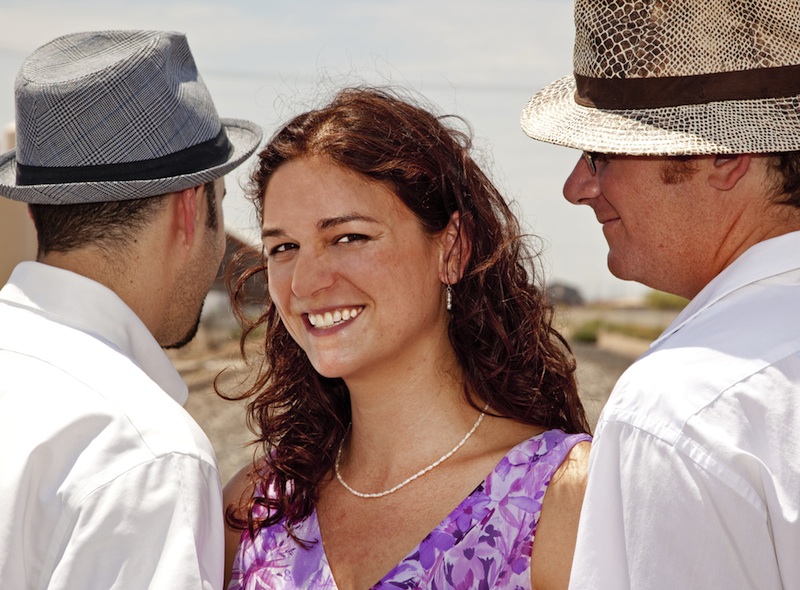5 Myths About Polyamory

Researchers estimate that as many as 5 percent of Americans are currently in relationships involving consensual nonmonogamy — that is, permission to go outside the couple looking for love or sex.
The boundaries in these relationships are remarkably varied, with some couples negotiating one-off "swinging" or partner-swapping experiences. and others forming stable bonds among three, four or five partners simultaneously. The latter is a version of polyamory, relationships in which people have multiple partnerships at once with the full knowledge of all involved.
Polyamorous people have largely flown under the radar, but that's beginning to change as psychologists become intrigued by this unusual group. The first annual International Academic Polyamory Conference takes place Feb. 15 in Berkeley, Calif., and ongoing studies are examining everything from how jealousy works in polyamorous relationships to how kids in polyamorous familes fare. Though there's a lot left to learn, initial findings are busting some myths about how love among many works.
Myth #1: Poly people are unsatisfied
When someone goes outside a relationship looking for companionship or sex, it's natural to assume there's something missing from their romance. But that doesn't appear to be the case for polyamorous individuals.
Melissa Mitchell, a graduate student in psychology at the University of Georgia, conducted research while at Simon Frasier University in Canada on 1,093 polyamorous individuals. The participants were asked to list a primary partner and a secondary partner (more on that later), and they averaged nine years together with their primary and about two-and-a-half years with their secondary.
Mitchell and her colleagues surveyed their participants about how satisfied and fulfilled they felt in their relationships. They found that people were more satisfied with, felt more close to and more supported by their primary partner, suggesting that their desire for a secondary partner had little to do with dissatisfaction in the relationship. And satisfaction with an outside partner didn't hurt the primary relationship. [6 Scientific Tips for a Successful Marriage]
Get the world’s most fascinating discoveries delivered straight to your inbox.
"Polyamorous relationships are relatively independent of one another," Mitchell said in January at the annual meeting of the Society for Personality and Social Psychology in New Orleans. "We tend to assume in our culture that if you have your needs met outside your relationship, some kind of detrimental effect is going to result, and that's not what we find here."
Myth #2: Polyamorous people are still paired up
Many polyamorous people do form relationships that orbit around a committed couple, with each person having relationships on the side. But the primary partner/secondary partner model is an oversimplification for many poly relationships, said Bjarne Holmes, a psychologist at Champlain College in Vermont.
"I'd say about 30 percent or so of the polyamorous population would say they think of one partner as being primary," Holmes told LiveScience. "A large part of the population would say, 'No, I don't buy into that idea of primary or secondary.'"
Many polyamorous people resist that hierarchy and say they get different things out of different relationships, Holmes said. There are also many people who live in triads or quads, in which three or four people have relationships with each other or with just one or a few members of the group.
"What I've come across most is actually configurations of two males and a female living together," Holmes said.
Myth #3: Polyamory is a way to avoid commitment
Research by Amy Moors, a graduate student at the University of Michigan, finds that people whose relationship style involves little emotional entanglement often say they'd love a polyamorous relationship, thinking that they could have the benefits of coupledom without too much attachment.
Wrong. Joining a polyamorous relationship and thinking it's going to be a commitment-free breeze would likely be a huge mistake. For one thing, plenty of polyamorous relationships are very serious and stable — Holmes says he's interviewed people who've been legally married for 40 years and in a relationship with a second partner for 20.
Secondly, successful polyamorous partners communicate relentlessly, Holmes said: "They communicate to death." It's the only way to ensure that everyone's needs are met and no one is feeling jealous or left out in a relationship that involves many people.
Myth #4: Polyamory is exhausting
The monogamists in the crowd may be shaking their heads. Isn't all that communication and negotiation exhausting? It's true that polyamorous relationships take lots of time, said Elizabeth Sheff, a legal consultant and former Georgia State University professor who is writing a book on polyamorous families.
"Even if you're able to hang out together, giving four relationships the amount of care and feeding and maintenance they need can be a full-time job," Sheff told LiveScience. [Life's Extremes: Polyamory vs. Monogamy]
But people who thrive in polyamory seem to love that job, Holmes said. Polyamorous people report feeling energized by their multiple relationships and say that good feelings in one translate to good feelings in others.
"I had someone describe to me that love breeds more feelings of love," Holmes said.
Myth #5: Polyamory is bad for the kids
One big question about polyamory is how it affects families with children. The answer to that is not entirely clear — there have been no large-scale, long-term studies on the outcomes of kids growing up with polyamorous parents.
But some early research is suggesting that polyamory doesn't have to have a bad impact on the kids. Sheff has interviewed more than 100 members of polyamorous families, including about two dozen children of polyamorous parents ranging in age from 5 to 17 years old.
Parents list some disadvantages of the polyamorous lifestyle for their kids, namely stigma from the outside world and the danger of a child becoming attached to a partner who might later leave the arrangement, a risk most tried to ameliorate by being extremely cautious about introducing partners to their children.
For their part, kids in the 5- to 8-year-old range were rarely aware that their families were different from the norm, Sheff found. They thought about their parents' boyfriends and girlfriends as they related to themselves, not as they related to mom or dad.
"A 6-year-old may not think of someone as mommy's girlfriend, but think of that person as 'the one who brings Legos' or 'the one who takes me out to ice cream,'" Sheff said.
From ages 9 to 12, kids became more aware of their families as different, but mostly said it was easy to stay "closeted," because people tend to mistake polyamorous arrangements as blended families or other relics of modern relationship complexity. The teens in the 13- to 17-year-old crowd tended to take a more in-your-face approach, Sheff said, "an approach of, 'If you think this is wrong you're going to have to prove it to me. My family is fine.'"
Some teens indicated that they'd consider polyamory for themselves; others weren't interested at all.
Both parents and kids saw advantages to the polyamorous lifestyle as well. For parents, having more than two adults on hand to help with child-rearing could be a lifesaver. Kids also reported liking having multiple adults whom they trusted — though they complained that with so much supervision, they couldn't get away with anything. Children also spoke of the advantages of growing up knowing they could make their own decisions about how to build their families.
The results are likely somewhat optimistic, Sheff said, as dysfunctional families are usually less likely to volunteer for studies. But the lack of widespread trauma among the children of polyamorous families suggests that polyamory is not, by definition, terrible for kids.
"One of the main things this does indicate to me is that these families can be really good places to raise children," Sheff said. "Not necessarily that all of them, definitionally, are, but that they may be, depending on how families work it out."
Follow Stephanie Pappas on Twitter @sipappas or LiveScience @livescience. We're also on Facebook & Google+.

Stephanie Pappas is a contributing writer for Live Science, covering topics ranging from geoscience to archaeology to the human brain and behavior. She was previously a senior writer for Live Science but is now a freelancer based in Denver, Colorado, and regularly contributes to Scientific American and The Monitor, the monthly magazine of the American Psychological Association. Stephanie received a bachelor's degree in psychology from the University of South Carolina and a graduate certificate in science communication from the University of California, Santa Cruz.


